MULE CROSSING: Much Ado About Mules
By Meredith Hodges
 In the early sixties, mules were among those animals quickly becoming extinct in this country. Thanks to the formation of clubs such as The American Donkey and Mule Society, founded in 1967, and the British Donkey Breed Society, founded in 1966, the trend was reversed and the animals began to get the recognition they justly deserved.
In the early sixties, mules were among those animals quickly becoming extinct in this country. Thanks to the formation of clubs such as The American Donkey and Mule Society, founded in 1967, and the British Donkey Breed Society, founded in 1966, the trend was reversed and the animals began to get the recognition they justly deserved.
With renewed interest in mules and donkeys, clubs and events are springing up all over the country and Colorado is no exception. Those of us in Colorado who have become mule lovers are invited to join the Rocky Mountain Longears Association. The meetings are held in Littleton, Colorado and a newsletter is sent out monthly to keep members informed of the club’s activities and to unite members of the club who cannot attend those meetings. The purpose and goals for this organization are as follows: to promote Longears and publicize the activities of our club, to promote well-mannered, usable, working Longeared animals, to provide entertainment and pleasurable activities for Longears, and to provide the opportunity for the members to help and learn from each other.
 For those of you who are unfamiliar with the breeding of a mule, he is the cross between a male donkey, called a jack, and a female horse, a mare. The reverse of that–a cross between a male horse, a stallion, and a female donkey, a jenny on jennet–is called a hinny, although many still refer to them as mules. Years ago people used low quality mares to breed to jacks to obtain mules, but today we are improving the breed by crossing better quality animals to obtain better and stronger mules.
For those of you who are unfamiliar with the breeding of a mule, he is the cross between a male donkey, called a jack, and a female horse, a mare. The reverse of that–a cross between a male horse, a stallion, and a female donkey, a jenny on jennet–is called a hinny, although many still refer to them as mules. Years ago people used low quality mares to breed to jacks to obtain mules, but today we are improving the breed by crossing better quality animals to obtain better and stronger mules.
The Lucky Three Ranch has come a long way since its beginning in 1980. The once 10-acre sheep ranch was successfully converted to a comfortable mule-breeding facility complete with a 14-stall barn, pens, indoor arena, and eight acres left in pasture in its earlier years. We began a breeding program with six broodmares, primarily Quarter Horses, at the ranch, four of which were in foal to Little Jack Horner almost immediately. The Lucky Three Ranch offered the option of obtaining a mule from the ranch, or if you preferred, you were invited to bring in your own mare to be bred to Little Jack Horner. L.J. became a proven sire. Breeding season at the Lucky Three Ranch was from March to August, at which time mares could be booked and brought to the ranch to be bred. Plans for breeding could also be made in advance of the breeding season although no mares were accepted until March. High health standards were maintained for the safety and well-being of the animals. Careful records were kept and a custom made breeding chute insured the safety of mares being bred. Visitors were encouraged to come and tour the facility provided that they called for an appointment first.
 Many have asked about the training of mules. Training mules is much like training horses, but sophisticated trainers would probably agree that they are more like teaching young children. A mule is more likely to perform to the best of his ability if he is allowed to build trust in his trainer. This is where mules and horses differ. Horses have a forgiving nature and are able to forget a loss of temper by the trainer; mules do not forget. When a mule is nervous about a trainer, his ability to perform for the trainer is impaired. Pat Parelli, a California mule trainer, put it quite nicely: “Mules separate crude trainers from artistic trainers.” The mule handled by a crude trainer will generally epitomize the traditional belief that mules are stubborn and ornery. The mule handled by an artistic trainer will not. A technique widely used among mule trainers with great success is the psychological science of Behavior Modification, whereby the animal’s natural behaviors are modified to achieve the desired response through the use of positive reinforcement. Negative reinforcement is also used sparingly. When using negative reinforcement, one must remain calm, patient, and just to ensure the success of the temporary discipline. One must remember that negative reinforcement does not build desirable behavior. It is only used to stop a bad behavior long enough to substitute a desirable behavior. A mule trained in this manner will become a more trustworthy, willing, and predictable friend and companion. Let’s dispel the old saying that mules are “stubborn” and “ornery” and say that there are really no bad mules, only bad trainers.
Many have asked about the training of mules. Training mules is much like training horses, but sophisticated trainers would probably agree that they are more like teaching young children. A mule is more likely to perform to the best of his ability if he is allowed to build trust in his trainer. This is where mules and horses differ. Horses have a forgiving nature and are able to forget a loss of temper by the trainer; mules do not forget. When a mule is nervous about a trainer, his ability to perform for the trainer is impaired. Pat Parelli, a California mule trainer, put it quite nicely: “Mules separate crude trainers from artistic trainers.” The mule handled by a crude trainer will generally epitomize the traditional belief that mules are stubborn and ornery. The mule handled by an artistic trainer will not. A technique widely used among mule trainers with great success is the psychological science of Behavior Modification, whereby the animal’s natural behaviors are modified to achieve the desired response through the use of positive reinforcement. Negative reinforcement is also used sparingly. When using negative reinforcement, one must remain calm, patient, and just to ensure the success of the temporary discipline. One must remember that negative reinforcement does not build desirable behavior. It is only used to stop a bad behavior long enough to substitute a desirable behavior. A mule trained in this manner will become a more trustworthy, willing, and predictable friend and companion. Let’s dispel the old saying that mules are “stubborn” and “ornery” and say that there are really no bad mules, only bad trainers.
The success of this method of training was reflected in the accomplishments of Lucky Three Sundowner, the first mule I brought to Colorado. He was sired by Windy Valley Adam and out of Candy Etta, a registered Quarter Horse mare. Sundowner stood 16 hands tall as a three year old. He won first place in the halter class for saddle mules, 56” and over at the National Western Stock Show in January of 1983, then went on to take first place in the Mule Reining competition at the Colorado State Fair in August of 1983. He was shown again at the National Western Stock Show January 14, 1984, in Halter, Western Pleasure, and Reining. Then it was on to the Bishop Mule Days World Show over Memorial Day Weekend 1984.
 The Mule Days celebration in Bishop, California is the largest mule show in the world. Mule lovers, their friends and family enjoy four days of mule-related fun and entertainment. At this particular show there is a little something for everyone: Western cuisine, games, dancing, and conversation in addition to the mule show itself. In 1984, there were over 70 different classes and events for the competitors such as Pleasure classes, Reining classes, Trail, Musical Tires, Barrel Racing and Pole Bending. Also Jumping, Cattle Penning, Steer Stopping, Team Roping, and a Balloon Bust. For the packers: Pack Train classes, Packing contests, Box Hitch and Diamond Hitch packing contests (pro and non-pro), Team Packing and the Team Packing Scramble which you have to see to believe! There are Halter classes, Pulling, Driving classes, and for you race fans: Chariot races, Flat Track races, and yes, even a Backwards race! To highlight the events, there are featured performances by special people and mules. Almost every year, the 20-mule team makes an appearance and in 1981 Slim Pickens, Grand Marshall of the Mule Days Parade, drove his team to victory in a chariot race! In 1984, Colorado’s own Al Kaly Shrine Temple Mule Train World Champion Drill Team out of Colorado Springs gave a memorable performance on their beautifully matched, black army mules. This mule show brings together so many people with different backgrounds and interests for a perfectly glorious weekend. Each year leaves you looking forward to the next.
The Mule Days celebration in Bishop, California is the largest mule show in the world. Mule lovers, their friends and family enjoy four days of mule-related fun and entertainment. At this particular show there is a little something for everyone: Western cuisine, games, dancing, and conversation in addition to the mule show itself. In 1984, there were over 70 different classes and events for the competitors such as Pleasure classes, Reining classes, Trail, Musical Tires, Barrel Racing and Pole Bending. Also Jumping, Cattle Penning, Steer Stopping, Team Roping, and a Balloon Bust. For the packers: Pack Train classes, Packing contests, Box Hitch and Diamond Hitch packing contests (pro and non-pro), Team Packing and the Team Packing Scramble which you have to see to believe! There are Halter classes, Pulling, Driving classes, and for you race fans: Chariot races, Flat Track races, and yes, even a Backwards race! To highlight the events, there are featured performances by special people and mules. Almost every year, the 20-mule team makes an appearance and in 1981 Slim Pickens, Grand Marshall of the Mule Days Parade, drove his team to victory in a chariot race! In 1984, Colorado’s own Al Kaly Shrine Temple Mule Train World Champion Drill Team out of Colorado Springs gave a memorable performance on their beautifully matched, black army mules. This mule show brings together so many people with different backgrounds and interests for a perfectly glorious weekend. Each year leaves you looking forward to the next.
Even those who do not ride can enjoy the fun and frolic sponsored by “Longears” clubs. The mules of today have truly given new meaning to the word “mule”. The days of the ornery, stubborn, work mule are gone, and in its place, is a wonderfully entertaining new breed capable of competing in any area of equine athletics, performing for charity benefits, and more. Before dismissing him too hastily, see for yourself what he can do at any of Colorado’s mule events. Event schedules can be obtained from any Rocky Mountain Longears Association member. So ask. Join the millions of people who are discovering mules. He’s an intelligent, surefooted, sensible, and entertaining animal, so why not give him a try?
To learn more about Meredith Hodges and her comprehensive all-breed equine training program, visit LuckyThreeRanch.com, MEREDITH HODGES PUBLIC FIGURE Facebook page, or call 1-800-816-7566. Check out her children’s website at JasperTheMule.com. Also, find Meredith on Pinterest, Instagram, MeWe, YouTube and Twitter.
Covered in TRAINING MULES & DONKEY: A LOGICAL APPROACH TO TRAINING, TRAINING WITHOUT RESISTANCE and EQUUS REVISITED at www.luckythreeranchstore.com.
© 1984, 2016, 2024 Lucky Three Ranch, Inc. All Rights Reserved.

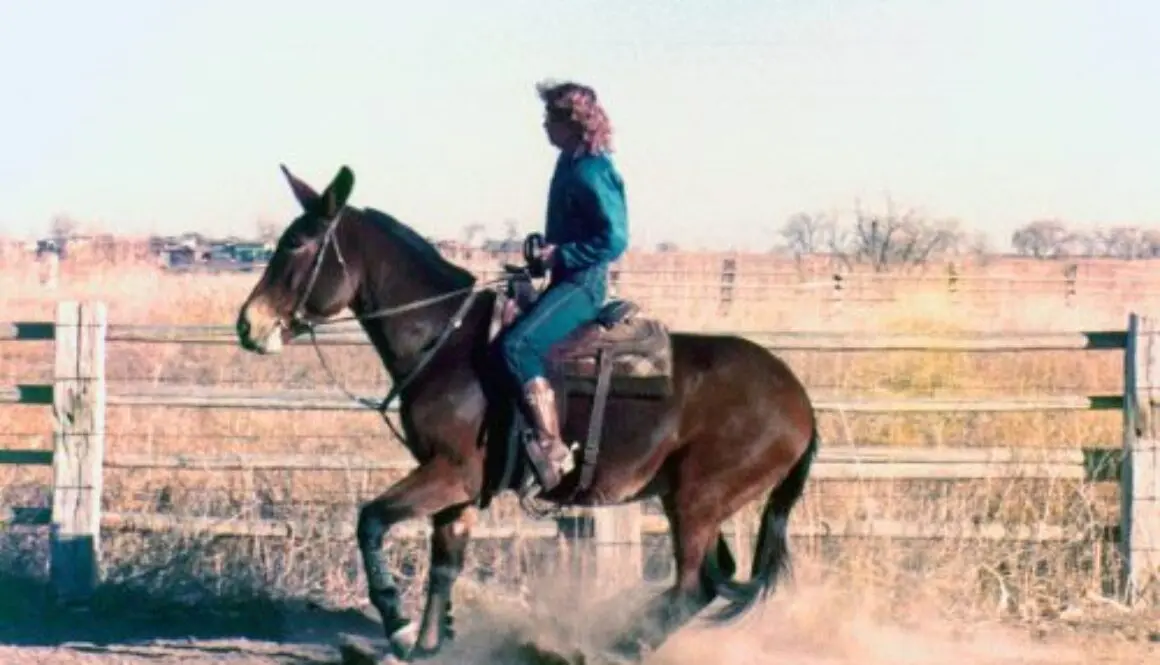

 Most of the world’s calendars begin with New Year’s, but a mule lover’s calendar begins and ends with Bishop Mule Days held in Bishop, California, over Memorial Day weekend each year. This year marked the 17th Annual Mule Days Celebration with over 600 mules participating in everything from the parade to packing to steer roping and jumping. But Bishop Mule Days is more than just a mule show. It is an annual rendezvous of mule lovers from all over the world. It is an opportunity for these people to come together, exchange ideas, demonstrate their talents and pay their respects to the one animal most responsible for the building of this great country of ours – the mule!
Most of the world’s calendars begin with New Year’s, but a mule lover’s calendar begins and ends with Bishop Mule Days held in Bishop, California, over Memorial Day weekend each year. This year marked the 17th Annual Mule Days Celebration with over 600 mules participating in everything from the parade to packing to steer roping and jumping. But Bishop Mule Days is more than just a mule show. It is an annual rendezvous of mule lovers from all over the world. It is an opportunity for these people to come together, exchange ideas, demonstrate their talents and pay their respects to the one animal most responsible for the building of this great country of ours – the mule! Just as the mule has suffered great injustice to his character throughout the ages, so have his admirers and advocates. Stories and rumors have repeatedly portrayed the mule as an unattractive, stubborn creature, but modern day mule lovers have found that these rumors are simply not true. Fast breaking and gross impatience are probably the underlying reasons for such ignorant remarks. Mule lovers today are doing their level best to educate the general public about the true nature of the mule. The simple fact is that he’s generally better than the horse out of which he came, and much more personable!
Just as the mule has suffered great injustice to his character throughout the ages, so have his admirers and advocates. Stories and rumors have repeatedly portrayed the mule as an unattractive, stubborn creature, but modern day mule lovers have found that these rumors are simply not true. Fast breaking and gross impatience are probably the underlying reasons for such ignorant remarks. Mule lovers today are doing their level best to educate the general public about the true nature of the mule. The simple fact is that he’s generally better than the horse out of which he came, and much more personable! The hard work and dedication of the owners, Dr. Robert and Debbie Miller and trainer of “Jord Ass Jean” was also quite apparent; she exhibited the grace and agility of a truly fine animal. Congratulations on tying for World Champion Performance Mule! It was well earned. Not to be outdone by horseracing, mule-racing fans cheered the victory of Cajun Queen, owned by J.P. Rogers, as the World Champion Running Mule. She was indeed a queen! Demonstrating speed and skill, the World Champion Packer was awarded to Tony Holdridge of the Red’s Meadows Pack Outfit. He did it so smoothly! The best for the best – good mules need a good farrier and Lee Green was where it’s at! Congratulations to our World Champion Farrier! Is it that wonderfully loud shirt, or was it the mule? Congratulations to Johnny Enos and Poco Streak, the 1986 World Champion Working Mule!
The hard work and dedication of the owners, Dr. Robert and Debbie Miller and trainer of “Jord Ass Jean” was also quite apparent; she exhibited the grace and agility of a truly fine animal. Congratulations on tying for World Champion Performance Mule! It was well earned. Not to be outdone by horseracing, mule-racing fans cheered the victory of Cajun Queen, owned by J.P. Rogers, as the World Champion Running Mule. She was indeed a queen! Demonstrating speed and skill, the World Champion Packer was awarded to Tony Holdridge of the Red’s Meadows Pack Outfit. He did it so smoothly! The best for the best – good mules need a good farrier and Lee Green was where it’s at! Congratulations to our World Champion Farrier! Is it that wonderfully loud shirt, or was it the mule? Congratulations to Johnny Enos and Poco Streak, the 1986 World Champion Working Mule! As more people are educated about mules, we see more participants in Bishop Mule Days. Ordinarily Bishop is a town of only 4000 people, but streets were lined with 50,000 spectators for the Mule Days Parade, the largest non-motorized parade in the world. In 1986, the parade consisted of 240 entries. Among those entries were real diehards such as the Vision Quest Wagon Train and Tindell Wagon Train. Both wagon trains travelled over 300 miles to take part in the Bishop Mule Days Celebration. The impressions they left along the way will probably go down in history. Once arrived, the young adults from Vision Quest gave us an extra-special treat with their multi-talented marching drill team. Our deepest thanks for their special contribution!
As more people are educated about mules, we see more participants in Bishop Mule Days. Ordinarily Bishop is a town of only 4000 people, but streets were lined with 50,000 spectators for the Mule Days Parade, the largest non-motorized parade in the world. In 1986, the parade consisted of 240 entries. Among those entries were real diehards such as the Vision Quest Wagon Train and Tindell Wagon Train. Both wagon trains travelled over 300 miles to take part in the Bishop Mule Days Celebration. The impressions they left along the way will probably go down in history. Once arrived, the young adults from Vision Quest gave us an extra-special treat with their multi-talented marching drill team. Our deepest thanks for their special contribution! Sunday afternoon, Wadi, an Appaloosa mule, was chosen for the part. Congratulations, Wadi! In addition, Dix Country Pictures will also be putting together a documentary about the Bishop Mule Days Celebration. With their enthusiastic help, we should be able to reach more people than ever in praise of mules! In addition to the actual mule show, special events and people are an important part of Bishop Mule Days. The Governor of California, George Deukmejian participated in the parade and later held a press conference. Ted Dawson, award-winning sportscaster for KABC-PV Los Angeles, was honored as Grand Marshall for the Bishop Mule Days Parade. Struck with “Mule Fever,” enthusiastic Ted also participated in many mule events, with his memorable performance being in the musical tires class. Surely, it is a time he will never forget…and neither will we! Semi-truck pulls, steer packing, large hitch demonstrations, and races with eight to ten mules per wagon were just a few of many special events enjoyed by spectators that year.
Sunday afternoon, Wadi, an Appaloosa mule, was chosen for the part. Congratulations, Wadi! In addition, Dix Country Pictures will also be putting together a documentary about the Bishop Mule Days Celebration. With their enthusiastic help, we should be able to reach more people than ever in praise of mules! In addition to the actual mule show, special events and people are an important part of Bishop Mule Days. The Governor of California, George Deukmejian participated in the parade and later held a press conference. Ted Dawson, award-winning sportscaster for KABC-PV Los Angeles, was honored as Grand Marshall for the Bishop Mule Days Parade. Struck with “Mule Fever,” enthusiastic Ted also participated in many mule events, with his memorable performance being in the musical tires class. Surely, it is a time he will never forget…and neither will we! Semi-truck pulls, steer packing, large hitch demonstrations, and races with eight to ten mules per wagon were just a few of many special events enjoyed by spectators that year. All the way from Colorado, the Coors Belgian Hitch gave several impressive performances during the weekend show. Under the steady hand of Jim Hilgendorf, the Belgians exhibited an awesome display of power and grace. Monty Montana, 1978 Grand Marshall of the Mule Days Parade, returned to tantalize the crowd with his intricate rope tricks and trick riding, a wonderful contribution to Mule Days. Even the United States Armed Forces were represented at Bishop Mule Days – two were from the Mountain Warfare Training Center. Rumor has it that mules will still be replacing some modes of transportation in the more mountainous regions. The overall feeling is that mules would be more practical and economical for this type of use.
All the way from Colorado, the Coors Belgian Hitch gave several impressive performances during the weekend show. Under the steady hand of Jim Hilgendorf, the Belgians exhibited an awesome display of power and grace. Monty Montana, 1978 Grand Marshall of the Mule Days Parade, returned to tantalize the crowd with his intricate rope tricks and trick riding, a wonderful contribution to Mule Days. Even the United States Armed Forces were represented at Bishop Mule Days – two were from the Mountain Warfare Training Center. Rumor has it that mules will still be replacing some modes of transportation in the more mountainous regions. The overall feeling is that mules would be more practical and economical for this type of use. Each year, before the Saturday and Sunday evening performances, a very special lady, Nita Vick makes her contribution to Bishop Mule Days. Affectionately known as “Sarge,” she takes rookie volunteers and shapes them into the Bishop Mule Days Drill Team. No one would know from the actual performances that this team had the absolute minimum practice time, only one hour of practice before the performance on Saturday and only one hour before practice on Sunday! Their performance “Under the Flags” is a sight to see!
Each year, before the Saturday and Sunday evening performances, a very special lady, Nita Vick makes her contribution to Bishop Mule Days. Affectionately known as “Sarge,” she takes rookie volunteers and shapes them into the Bishop Mule Days Drill Team. No one would know from the actual performances that this team had the absolute minimum practice time, only one hour of practice before the performance on Saturday and only one hour before practice on Sunday! Their performance “Under the Flags” is a sight to see! Mule Days is the most important American Association Show – it appeals to everyone in some way. Western cuisine, Western art shows and Western dances add to the overall picture of Bishop Mule Days. Fiddlers across America rosin up their bows for the Mule Days Fiddling Contest. As they wandered the grounds serenading the crowds, they were joined in harmony by singing donkeys and mules, and dancing exhibitions and spectators. A fun time was had by all! Bishop Mule Days is more than just a mule show. The area around Bishop is filled with mountain lakes and streams and offers backpacking and hiking, fishing, swimming and even skiing. Couple this with unique and spectacular entertainment and you have the opportunity for the time of your life! Memorial Day weekend is the beginning of the year for these maligned animals and the unique people who love them!
Mule Days is the most important American Association Show – it appeals to everyone in some way. Western cuisine, Western art shows and Western dances add to the overall picture of Bishop Mule Days. Fiddlers across America rosin up their bows for the Mule Days Fiddling Contest. As they wandered the grounds serenading the crowds, they were joined in harmony by singing donkeys and mules, and dancing exhibitions and spectators. A fun time was had by all! Bishop Mule Days is more than just a mule show. The area around Bishop is filled with mountain lakes and streams and offers backpacking and hiking, fishing, swimming and even skiing. Couple this with unique and spectacular entertainment and you have the opportunity for the time of your life! Memorial Day weekend is the beginning of the year for these maligned animals and the unique people who love them!
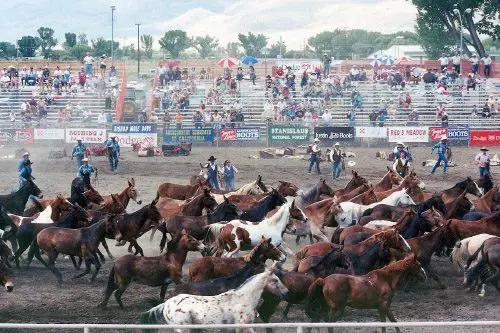




 By Meredith Hodges
By Meredith Hodges Over 600 mules competed in more than 100 different events, including packing scrambles, English and Western classes and games, mule shoeing and comedy and specialty acts. As mules have progressed in their unique abilities, the art of Dressage has been added to the agenda. Lucky Three Sundowner of the Lucky Three Ranch in Loveland, Colorado, was invited to exhibit his grace and ability toward dance in an exhibition during the Sunday afternoon performance. He was the highest level Dressage mule to perform at Bishop this year. Lucky Three Mae Bea C.T. preceded the exhibition by winning the Mule Jumping class with no faults!
Over 600 mules competed in more than 100 different events, including packing scrambles, English and Western classes and games, mule shoeing and comedy and specialty acts. As mules have progressed in their unique abilities, the art of Dressage has been added to the agenda. Lucky Three Sundowner of the Lucky Three Ranch in Loveland, Colorado, was invited to exhibit his grace and ability toward dance in an exhibition during the Sunday afternoon performance. He was the highest level Dressage mule to perform at Bishop this year. Lucky Three Mae Bea C.T. preceded the exhibition by winning the Mule Jumping class with no faults! During the Saturday and Sunday performances, Bobby Tanner and friends reenacted the old 20-mule team hitch exhibition with mules that had only been hitched together since the preceding Monday afternoon! Such skill and Mulemanship is a sight to see…for sure! Another skillful performance was demonstrated by the Bishop Mule Days Drill Team comprised of exhibitors who practiced only once before each performance over the weekend under the strict and skillful command of Nita Vick, fondly known as “Sarge.” Pack scrambles, chariot races and comedy packing kept the audience in suspense and stitches with their wild and crazy antics. Rodeo announcer Bob Tallman added still more fun and excitement to the weekend events with his outlandish quips and stories. Other highlights included the Country Western dances on Friday, Saturday and Sunday nights, preceded on Thursday night by hit songwriter Michael Martin Murphy, who captured the audiences with hit tunes from past, present, and future recording albums. Western artists, craftsmen and salesmen displayed their wares throughout the weekend with a wide variety of items and art from past to present day. Bishop merchants store windows were painted in celebration of “Mules” and mule memorabilia could be found everywhere!
During the Saturday and Sunday performances, Bobby Tanner and friends reenacted the old 20-mule team hitch exhibition with mules that had only been hitched together since the preceding Monday afternoon! Such skill and Mulemanship is a sight to see…for sure! Another skillful performance was demonstrated by the Bishop Mule Days Drill Team comprised of exhibitors who practiced only once before each performance over the weekend under the strict and skillful command of Nita Vick, fondly known as “Sarge.” Pack scrambles, chariot races and comedy packing kept the audience in suspense and stitches with their wild and crazy antics. Rodeo announcer Bob Tallman added still more fun and excitement to the weekend events with his outlandish quips and stories. Other highlights included the Country Western dances on Friday, Saturday and Sunday nights, preceded on Thursday night by hit songwriter Michael Martin Murphy, who captured the audiences with hit tunes from past, present, and future recording albums. Western artists, craftsmen and salesmen displayed their wares throughout the weekend with a wide variety of items and art from past to present day. Bishop merchants store windows were painted in celebration of “Mules” and mule memorabilia could be found everywhere!

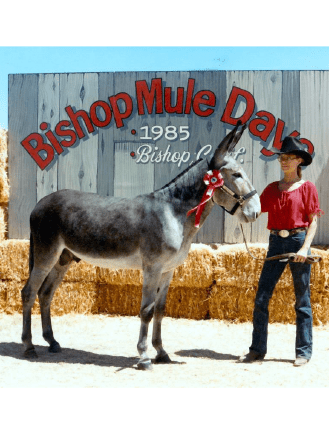 By Meredith Hodges
By Meredith Hodges Bishop Mule Days always has something for everyone. Mule lovers, their friends and family can enjoy fine Western cuisine, games, dancing and good conversation in addition to the show itself. The celebration is kicked off by three mule shows on Friday—there were over 90 different classes and events for competitors. They included: Pleasure classes, Reining classes, Trail, Musical Tires, Barrel Racing and Pole Bending. Also, Jumping, Cattle Penning, Steer Stopping, Team Roping, and a Balloon Bust. For the packers: Pack Train classes, Packing contests, Box Hitch and Diamond Hitch packing contests (pro and non-pro), Team Packing and the Team Packing Scramble, which you must see to believe!
Bishop Mule Days always has something for everyone. Mule lovers, their friends and family can enjoy fine Western cuisine, games, dancing and good conversation in addition to the show itself. The celebration is kicked off by three mule shows on Friday—there were over 90 different classes and events for competitors. They included: Pleasure classes, Reining classes, Trail, Musical Tires, Barrel Racing and Pole Bending. Also, Jumping, Cattle Penning, Steer Stopping, Team Roping, and a Balloon Bust. For the packers: Pack Train classes, Packing contests, Box Hitch and Diamond Hitch packing contests (pro and non-pro), Team Packing and the Team Packing Scramble, which you must see to believe! There was an Individual Packing Scramble for those wild and wooly mountain men or women who preferred to “go it light,” Western Saddle Races for those who wouldn’t be caught dead sitting on a postage stamp, and Forging and Hot Shoeing for our more artistic farriers. All these events and more were narrated by the “Man with the Magic Voice,” Bob Tallman from Reno, Nevada. He is one of many extra-special people who participated in this year’s Mule Days Celebration.
There was an Individual Packing Scramble for those wild and wooly mountain men or women who preferred to “go it light,” Western Saddle Races for those who wouldn’t be caught dead sitting on a postage stamp, and Forging and Hot Shoeing for our more artistic farriers. All these events and more were narrated by the “Man with the Magic Voice,” Bob Tallman from Reno, Nevada. He is one of many extra-special people who participated in this year’s Mule Days Celebration. the French archives as early as 1121. The breed has been protected by the French government and has remained pure for 300 years. Sonnette was one of only 60 Poitou donkeys in existence in 1985 and the only one of her kind in the United States. Her companion Savane was one of an estimated 150 Mulassiers in existence in 1985 and the only one of her kind in the United States. Mulassiers are a powerful draft horse used exclusively to breed with the Poitou ass to produce the Poitou mule, that has been extensively used in agriculture in France for hundreds of years. Seeing these two extremely rare animals was a very special treat indeed!
the French archives as early as 1121. The breed has been protected by the French government and has remained pure for 300 years. Sonnette was one of only 60 Poitou donkeys in existence in 1985 and the only one of her kind in the United States. Her companion Savane was one of an estimated 150 Mulassiers in existence in 1985 and the only one of her kind in the United States. Mulassiers are a powerful draft horse used exclusively to breed with the Poitou ass to produce the Poitou mule, that has been extensively used in agriculture in France for hundreds of years. Seeing these two extremely rare animals was a very special treat indeed!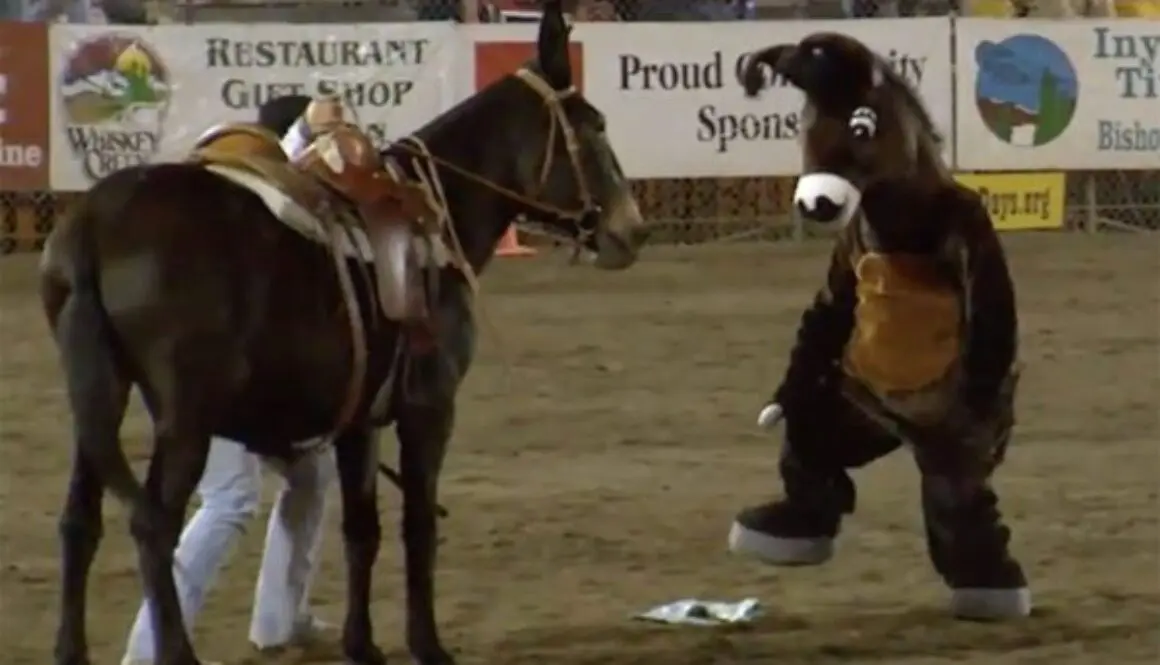

 Instead of going on the road to do clinics, I thought long and hard and decided to do an equestrian correspondence training course instead. I opted for this after considering that when I went to clinics as a student, I was one of 20 people and only got limited attention during those clinics. When I put into practice at home what I had learned at the clinics, I realized that I had only received the highlights of training and it was full of holes! When I tried to contact the clinicians to ask a question, I was either answered by someone in the office, or not answered at all. The clinicians were most often too busy and out of touch. The one thing I didn’t realize by making this decision was the incredible learning opportunity I had opened up for myself that I could, in turn, pass on to my clients.
Instead of going on the road to do clinics, I thought long and hard and decided to do an equestrian correspondence training course instead. I opted for this after considering that when I went to clinics as a student, I was one of 20 people and only got limited attention during those clinics. When I put into practice at home what I had learned at the clinics, I realized that I had only received the highlights of training and it was full of holes! When I tried to contact the clinicians to ask a question, I was either answered by someone in the office, or not answered at all. The clinicians were most often too busy and out of touch. The one thing I didn’t realize by making this decision was the incredible learning opportunity I had opened up for myself that I could, in turn, pass on to my clients. When they told me mules would not work well in a snaffle bit, I learned how to make that work. When they said they were not suitable for Dressage, I based my entire training program on those principles. When they told me not to give food rewards, I paid my mules for their efforts with a generous reward of crimped oats. When they told me not to talk to my equines, I spoke three languages to them: verbal language, body language and “touch” language. I can truthfully say that today I realize that it wasn’t the mules that were so stubborn, but rather…it was me! This positive kind of stubbornness did pay off, as I was to soon discover.
When they told me mules would not work well in a snaffle bit, I learned how to make that work. When they said they were not suitable for Dressage, I based my entire training program on those principles. When they told me not to give food rewards, I paid my mules for their efforts with a generous reward of crimped oats. When they told me not to talk to my equines, I spoke three languages to them: verbal language, body language and “touch” language. I can truthfully say that today I realize that it wasn’t the mules that were so stubborn, but rather…it was me! This positive kind of stubbornness did pay off, as I was to soon discover. Little Jack Horner had gone through my entire training series right along with my mules and had learned everything that I taught them. He may not have made it to Fourth Level Dressage, but he made it to Second Level Dressage with gait lengthening and lateral work. He overcame his “donkey” behaviors and gave a phenomenal performance, jumping four feet in exhibition at Bishop Mule Days. His Reining was accurate though somewhat limited by his donkey conformation. Still, he could always elicit a supportive laugh and a wide grin! He competed successfully at dressage driving shows and won world championships in driving at Bishop Mule Days.
Little Jack Horner had gone through my entire training series right along with my mules and had learned everything that I taught them. He may not have made it to Fourth Level Dressage, but he made it to Second Level Dressage with gait lengthening and lateral work. He overcame his “donkey” behaviors and gave a phenomenal performance, jumping four feet in exhibition at Bishop Mule Days. His Reining was accurate though somewhat limited by his donkey conformation. Still, he could always elicit a supportive laugh and a wide grin! He competed successfully at dressage driving shows and won world championships in driving at Bishop Mule Days. It was during this experience that I realized that Little Jack Horner had become deaf and could not hear one word of what I was saying, even when I was yelling. I was sitting in the Meadowbrook cart, he had blinders on his harness bridle and could not see me, so verbal language and body language were of no help to him at all. Lucky for us, we still had the “touch” language that we had developed between us and we thoroughly enjoyed the experience of driving yet again.
It was during this experience that I realized that Little Jack Horner had become deaf and could not hear one word of what I was saying, even when I was yelling. I was sitting in the Meadowbrook cart, he had blinders on his harness bridle and could not see me, so verbal language and body language were of no help to him at all. Lucky for us, we still had the “touch” language that we had developed between us and we thoroughly enjoyed the experience of driving yet again.
























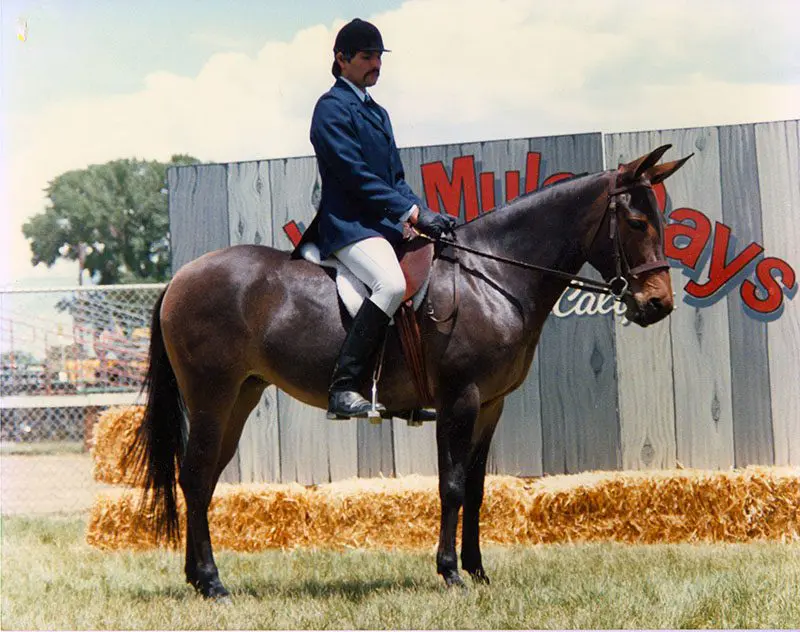 Today, we have more time to spend training our equines and cultivating our own riding skills. In most cases, the choice of tack is no longer of necessity, but of choice. Fashion, in any country, is supposed to be a statement of individuality and identity. The Western style of dress and tack suggests a hearty, rugged individual, surrounded by wide open spaces, using his equine as a partner for work. English attire paints a picture of dignity, reserve and concentrated skill. The Western image is a wonderfully romantic and picturesque way of seeing oneself, but it really doesn’t allow us the opportunity to improve our equestrian skills to the maximum. Western style riding is as limited as its uses. The smaller English saddle, made with a lot less leather, allows us to feel our equine’s body more closely (with the added stability of the stirrups) while we learn and exercise our bodies to become more harmonious with our mounts. As we can feel our equine more closely, so can he feel better the cues that we to give him. Thus, he can respond more accurately to our commands. However, most men don’t feel comfortable wearing “Sissy Pants” and riding in a “Sissy Saddle”—it just isn’t macho!
Today, we have more time to spend training our equines and cultivating our own riding skills. In most cases, the choice of tack is no longer of necessity, but of choice. Fashion, in any country, is supposed to be a statement of individuality and identity. The Western style of dress and tack suggests a hearty, rugged individual, surrounded by wide open spaces, using his equine as a partner for work. English attire paints a picture of dignity, reserve and concentrated skill. The Western image is a wonderfully romantic and picturesque way of seeing oneself, but it really doesn’t allow us the opportunity to improve our equestrian skills to the maximum. Western style riding is as limited as its uses. The smaller English saddle, made with a lot less leather, allows us to feel our equine’s body more closely (with the added stability of the stirrups) while we learn and exercise our bodies to become more harmonious with our mounts. As we can feel our equine more closely, so can he feel better the cues that we to give him. Thus, he can respond more accurately to our commands. However, most men don’t feel comfortable wearing “Sissy Pants” and riding in a “Sissy Saddle”—it just isn’t macho!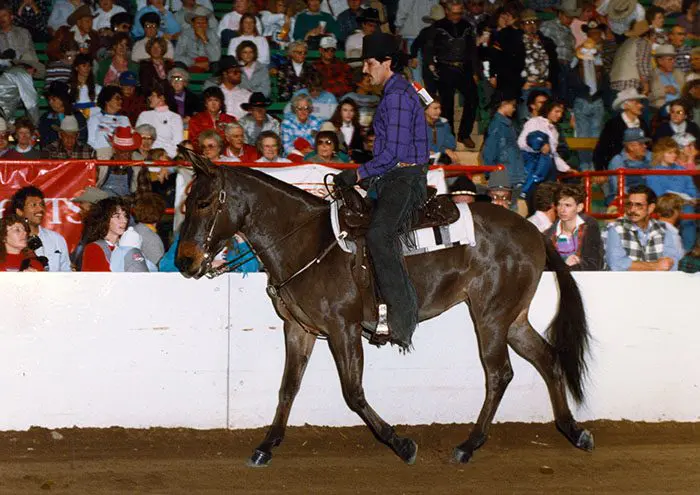 One Saturday morning, I finished a lesson with one of my students when Gary strolled into the indoor arena and announced that he was willing to give the English saddle a try, but that we would never get him into a pair of those “Sissy Pants!” “Fair enough,” I said, and brought my student’s horse around for him to ride. Getting on was a bit of a struggle, and exercises at the walk went really well, but as soon as the horse began to trot, Gary started bouncing. He was about to lose his balance, so he grabbed the rail to steady himself. The only problem was the rail stayed where it was and the horse kept going, leaving Gary dangling behind on the fence! I thought we would never stop laughing – he looked so ridiculous! Our macho man didn’t have the balance he thought he had!
One Saturday morning, I finished a lesson with one of my students when Gary strolled into the indoor arena and announced that he was willing to give the English saddle a try, but that we would never get him into a pair of those “Sissy Pants!” “Fair enough,” I said, and brought my student’s horse around for him to ride. Getting on was a bit of a struggle, and exercises at the walk went really well, but as soon as the horse began to trot, Gary started bouncing. He was about to lose his balance, so he grabbed the rail to steady himself. The only problem was the rail stayed where it was and the horse kept going, leaving Gary dangling behind on the fence! I thought we would never stop laughing – he looked so ridiculous! Our macho man didn’t have the balance he thought he had!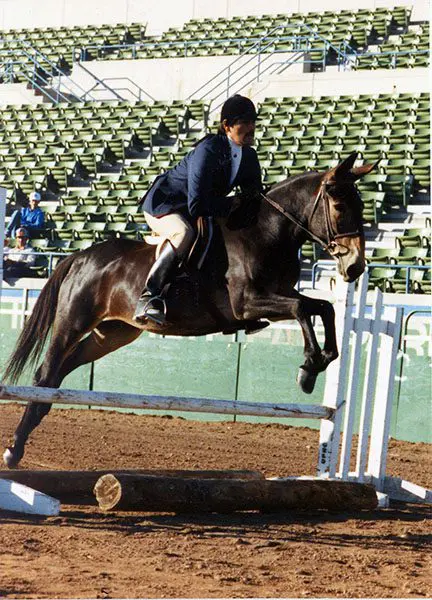 After a while Gary decided that English riding was, in fact, the best way to train. However, he still wasn’t too interested in “watching cement set” or doing Dressage tests. We decided after two years to start showing in Combined Training with the horses. We signed up for the second day of a two-phase show, not realizing that we would be asked to ride our Dressage tests the same day that we jumped. Two days before the show, Gary discovered that he would have to ride Training Level Test 1 at 9:00 A.M. the day of the show. We reviewed the test the day before the show, thinking that if all else failed I could read the test to him when he rode. Sunday morning, Gary was feeling tired, but confident. I took my place at “B” and prepared to read for him when the announcer explained that only United States Dressage Federation tests could have a reader, but not the same in Combined Training. Gary’s face turned ashen. I climbed back into the stands as he warmed up for his test… at the walk… lost in space! He stopped short below me and quietly said, “Meredith, will you please come here.” I ran down to see what the trouble was. “I can’t remember anything… I can’t do this!” he worried emphatically. I quickly explained the pattern. Gary’s first Dressage test ever in his first Combined Training show and he emerged in third place with a mule in the Elementary Division against 8 horses. Was he ever thrilled!
After a while Gary decided that English riding was, in fact, the best way to train. However, he still wasn’t too interested in “watching cement set” or doing Dressage tests. We decided after two years to start showing in Combined Training with the horses. We signed up for the second day of a two-phase show, not realizing that we would be asked to ride our Dressage tests the same day that we jumped. Two days before the show, Gary discovered that he would have to ride Training Level Test 1 at 9:00 A.M. the day of the show. We reviewed the test the day before the show, thinking that if all else failed I could read the test to him when he rode. Sunday morning, Gary was feeling tired, but confident. I took my place at “B” and prepared to read for him when the announcer explained that only United States Dressage Federation tests could have a reader, but not the same in Combined Training. Gary’s face turned ashen. I climbed back into the stands as he warmed up for his test… at the walk… lost in space! He stopped short below me and quietly said, “Meredith, will you please come here.” I ran down to see what the trouble was. “I can’t remember anything… I can’t do this!” he worried emphatically. I quickly explained the pattern. Gary’s first Dressage test ever in his first Combined Training show and he emerged in third place with a mule in the Elementary Division against 8 horses. Was he ever thrilled!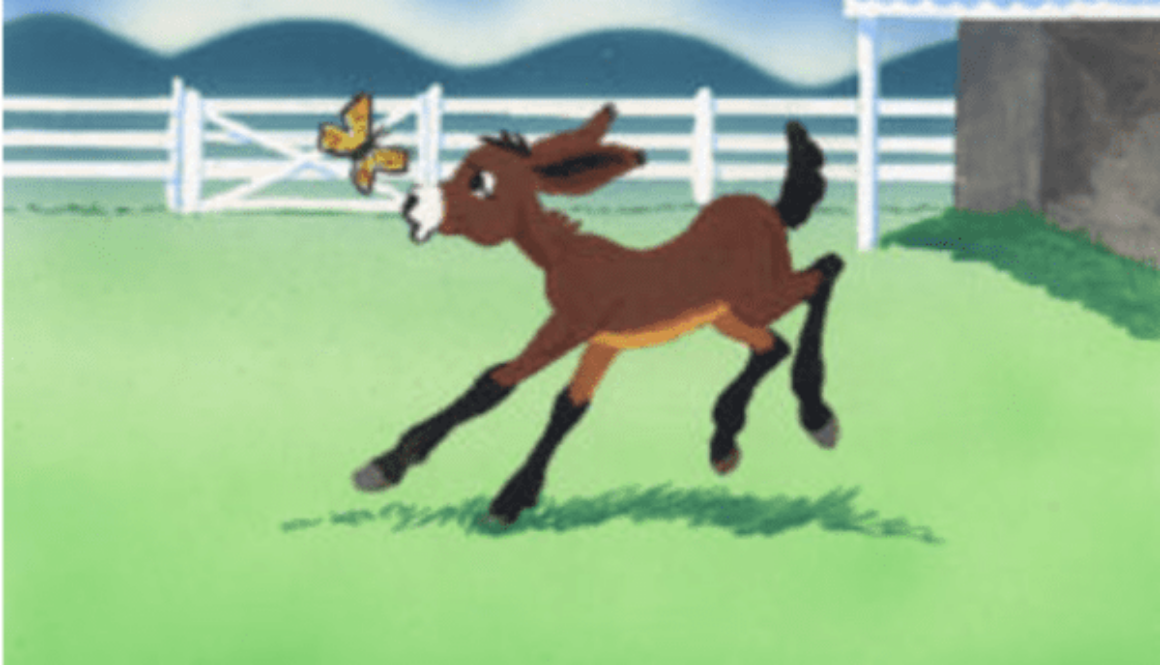
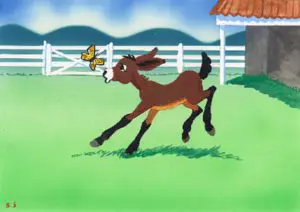 We were pastured on a couple of acres that surrounded an old shed where we used to get in out of the weather. My mother was content to graze and doze day after day – she wasn’t much on excitement. I used to love it when the people came and carried on about how cute I was. Then they would scratch and massage my fuzzy little body. They even got a little playful when I followed them around, romping, playing, and bumping them with my nose. “Oh, look how cute and friendly he is,” they’d say.
We were pastured on a couple of acres that surrounded an old shed where we used to get in out of the weather. My mother was content to graze and doze day after day – she wasn’t much on excitement. I used to love it when the people came and carried on about how cute I was. Then they would scratch and massage my fuzzy little body. They even got a little playful when I followed them around, romping, playing, and bumping them with my nose. “Oh, look how cute and friendly he is,” they’d say.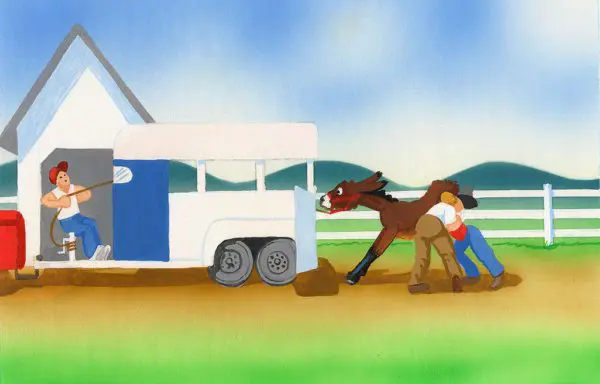 Suddenly, as soon as that “halter thing” was attached to my face, they tried to lead me away from my mother. That’s when I saw the little room on wheels parked along the pasture fence! I called to my mother to come… we were going for a ride! She took a couple of steps toward me when one of the two men shooed her off the other way. I was going alone with these two guys – but where?! Why?! I got scared! I pulled, kicked, bucked to get away, but nothing worked. They were both bigger than me and before long, I found myself locked in that little room on wheels… alone! I was frightened, but I was brave. The ride was short. When they finally opened the doors to let me out, I was an explosion of forced bravery. I came out of that trailer so fast I accidently knocked one of the men down. Whoops! Before I could show him how sorry I was, he jerked on my head and laced me about the head and neck with a long skinny stick that stung like a bee! Better stand still, I thought. Well, they didn’t like that either! They were pulling on my head and hitting me on the rear with that stinging stick! If I followed, it released the pressure from around my face and the man with the stick would stop, so I followed.
Suddenly, as soon as that “halter thing” was attached to my face, they tried to lead me away from my mother. That’s when I saw the little room on wheels parked along the pasture fence! I called to my mother to come… we were going for a ride! She took a couple of steps toward me when one of the two men shooed her off the other way. I was going alone with these two guys – but where?! Why?! I got scared! I pulled, kicked, bucked to get away, but nothing worked. They were both bigger than me and before long, I found myself locked in that little room on wheels… alone! I was frightened, but I was brave. The ride was short. When they finally opened the doors to let me out, I was an explosion of forced bravery. I came out of that trailer so fast I accidently knocked one of the men down. Whoops! Before I could show him how sorry I was, he jerked on my head and laced me about the head and neck with a long skinny stick that stung like a bee! Better stand still, I thought. Well, they didn’t like that either! They were pulling on my head and hitting me on the rear with that stinging stick! If I followed, it released the pressure from around my face and the man with the stick would stop, so I followed.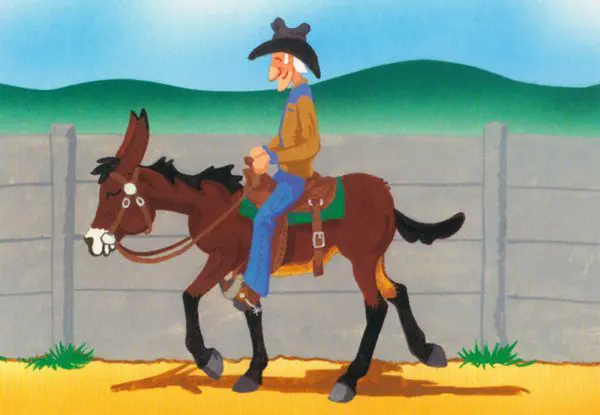 The day they put the saddle on my back when I was two was only one of many confusing times. I didn’t really mind the saddle until they fastened the belt around my middle so tight that I could hardly breathe. I bucked and ran, trying to get it off. “He’s going to be a real tough one,” the man said to my owner. I’m not really sure what he meant. I learned pretty quickly that the bucking only caused more pain as the stirrups thumped against my sensitive body. It was better to move smoothly with that saddle on my back, for sure. It took me awhile to learn to stop and turn when they pulled on that bit in my mouth, but the worst part was trying to keep my balance through all of this! Didn’t they know that I was still very young and growing and not really all that strong despite my size? They would ride me until I was stiff and sore, and then put me back in that small area with no room to stretch and exercise. They gave me rest for days at a time, with no other exercise. It seemed like I was either overworked or over-rested! My muscles never really had a chance to become stronger. They rode me either too long, or not at all. Somehow, though, I managed to learn. I guess we all do, whether it’s the hard way, or not.
The day they put the saddle on my back when I was two was only one of many confusing times. I didn’t really mind the saddle until they fastened the belt around my middle so tight that I could hardly breathe. I bucked and ran, trying to get it off. “He’s going to be a real tough one,” the man said to my owner. I’m not really sure what he meant. I learned pretty quickly that the bucking only caused more pain as the stirrups thumped against my sensitive body. It was better to move smoothly with that saddle on my back, for sure. It took me awhile to learn to stop and turn when they pulled on that bit in my mouth, but the worst part was trying to keep my balance through all of this! Didn’t they know that I was still very young and growing and not really all that strong despite my size? They would ride me until I was stiff and sore, and then put me back in that small area with no room to stretch and exercise. They gave me rest for days at a time, with no other exercise. It seemed like I was either overworked or over-rested! My muscles never really had a chance to become stronger. They rode me either too long, or not at all. Somehow, though, I managed to learn. I guess we all do, whether it’s the hard way, or not.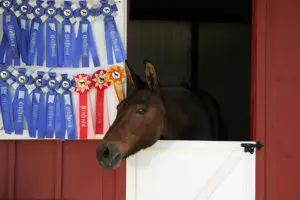 I met Mae Bea C.T. (“Peepers” from Jasper Goes to Bishop) and Ciji at Bishop Mule Days this year. They said that they have a wonderful life – equally balanced with training, pasture time, just plain fun and a lot of consideration for their feelings. Ciji said you were really mad at her for refusing all the jumps in the Hunter Under Saddle class, but that you were fair. You made her do them in the Jumping Class, rode the English Pleasure class and then let her rest for the remainder of the show since you knew she was in heat and had cramps. Ciji admitted that she can sometimes be a little stubborn and unfair herself, so she tried to make up for it by doing her best in the English Pleasure Class, which brought her fourth place.
I met Mae Bea C.T. (“Peepers” from Jasper Goes to Bishop) and Ciji at Bishop Mule Days this year. They said that they have a wonderful life – equally balanced with training, pasture time, just plain fun and a lot of consideration for their feelings. Ciji said you were really mad at her for refusing all the jumps in the Hunter Under Saddle class, but that you were fair. You made her do them in the Jumping Class, rode the English Pleasure class and then let her rest for the remainder of the show since you knew she was in heat and had cramps. Ciji admitted that she can sometimes be a little stubborn and unfair herself, so she tried to make up for it by doing her best in the English Pleasure Class, which brought her fourth place.